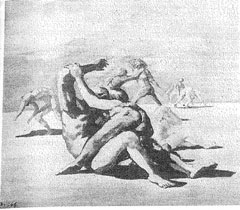”…Modern Japanese paintings from the private collection of Capt. James V. Coleman will be placed on private view this afternoon at the Tribune Book and Art Center and will be shown to the public beginning tomorrow. These paintings by contemporary Japanese artists were done since the American occupation and were recently brought to New York.”
GROUPS AND SIGNLY Landscapes of Four Centuries – Recent Japanese Paintings – Sculpture, New York Times, May 11, 1947)
”Two or three months after V-J Day, this writer spent several days searching Tokyo, Yokohama, and several nearby town for artistユs bristle brushes. Even cigarettes, chocolettos and a pocketful of yen failed to unearth a single one. (Eventually, one of Japan’s most famous artists, Harachi Yochida, directed me to an obscure shop near Ueno Park where I bought out the entire stock – a double handful – for about $6.50!) This will indicate how little oil painting was going on during the war and early days of the occupation. What little we saw was slavishly French Impressionist. Now, however, there is an extraordinary exhibition at New York’s Tribune Subway Gallery which demonstrates how much progress has been made by Nippon’s modern artists in the short time since then. This collection of paintings was made by James V. Coleman, lately of the Marine Corps, who helped reorganize Japan’s Communication System. Sixteen Japanese artists are represented, all unknown here, except Fujita and Itaru Tanabe. The paintings show amazing vitality and ferment. Most frequently the artists have adopted Western concepts of form, drawing and composition. But color, being a more emotional and intuitive element, is curiously oriental. The high point of the show is reached by young Fukuzawa in the atomic Hiroshima. American artists have shown a number of interpretations of the Bomb this season, but it remained for a Japanese artist to portray it with the greatest impact. The color is consistent with the Buddhist symbolism of hell, grief and destruction, but this painting is so expressive that even a Westerner will get the idea. Yamamoto, an ex-soldier in his early thirties, is outstanding with his powerful and penetrating portraits. – ALONZO LANSFORD. ”
(Post-War Nippinese, Art Digest vol.21, no.17, June 1, 1947))

”MODERN JAPANESE [Tribune Book & Art Center; to June 31] art shows how Westernized these young artists of postwar Japan have become, an impression heightened by the juxtaposition of traditional prints and scrolls. Assembled by an American Marine captain, the group includes one small cat by Fujita, well known in the school of Paris, and oils by artists who have never been to Europe, but show marked surrealist and Impressionist trends. Among these are Fukuzawa’s symbolic series of struggling bodies(he was jailed for pacifism), Yamamoto’s portraits in chiaroscuro, and a startling Renoiresque nude Japanese girl by Hiromachi. Not for sale. ”
(Art News, vol.XLVI, no.4, June 1947)
